In April 2022, Bore Place was awarded grant funding from DEFRA and Kent Downs AONB through a project called Farming in Protected Landscapes. The ambition of the project was to highlight the importance of connecting people to nature, educate around farming and especially how we are on a journey of understanding how to farm in an ecological way, working with nature whilst producing nutritional, high-quality milk.
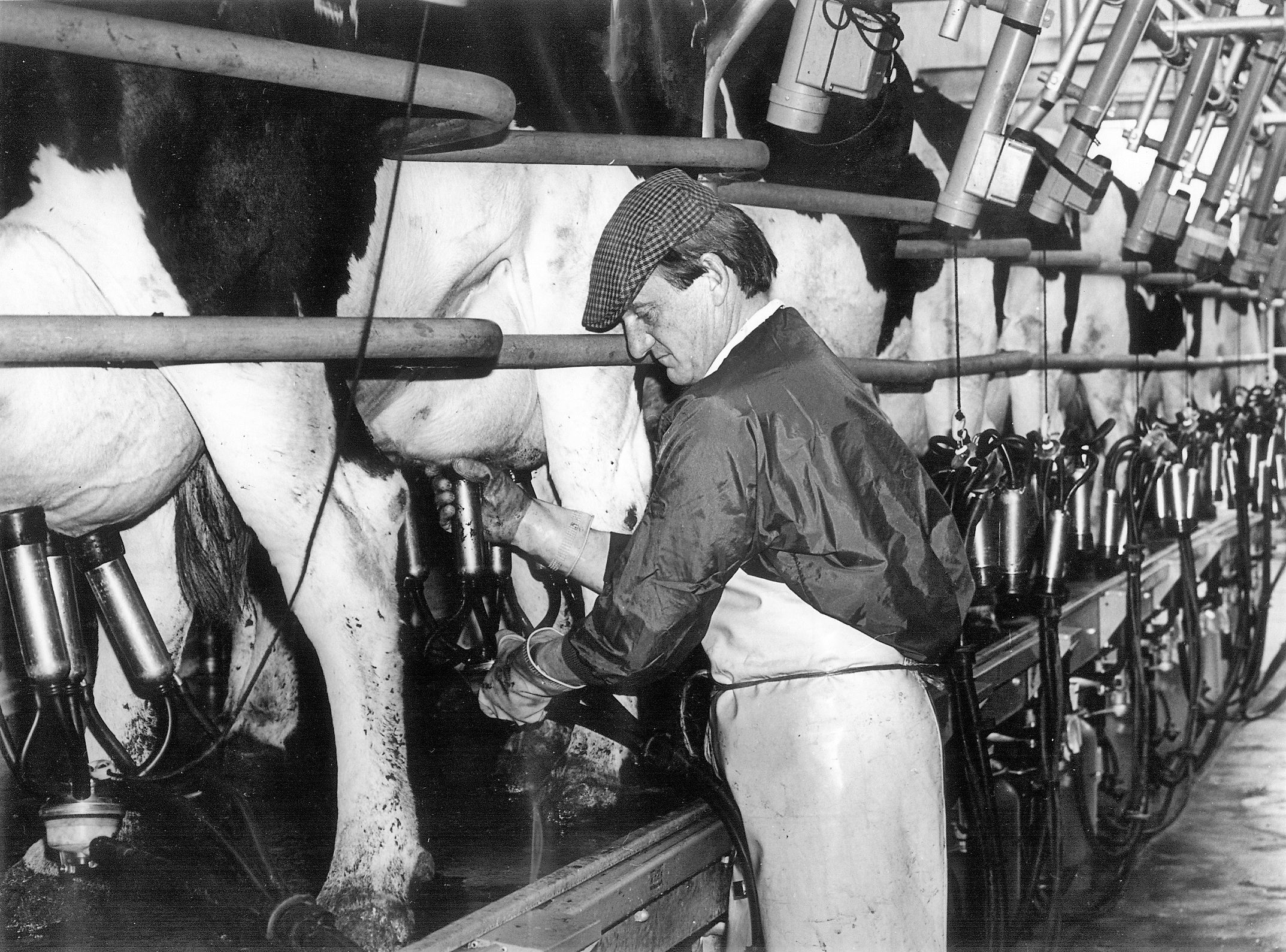
Neil Wates, founder of Bore Place milking in the early days
Dairy farming is at the roots of Bore Place’s heritage. As Jenifer and Neil Wates embarked on their mission to establish the Commonwork Trust (the charitable organisation which makes up Bore Place) it was a very early decision to introduce the dairy herd to our landscape. Excavations began to set-up our farm building footprint, the clay that was removed to make space for these structures was used in our brickworks, where some of the bricks that were made remain on-site, in our courtyard garden and our pizza oven. Experimental ventures began in the late 80’s including producing drinking yoghurt but only until now - 47 years later we are finally welcoming visitors to enjoy fresh produce from our brand-new Farm Gate. In the late 1970’s Neil Wates invested in what was at the time ground-breaking regarding green energy production – a methane digester. The digester generated all the farm electricity from the gas processed from cow manure, and this also sterilised the manure which led to the establishment of Supernatural Ltd (producing compost using this natural fertiliser) whose managing director at the time was David Hawkes. Both David and John Waller (our on-site underwoodsman) are responsible for building our fantastic new Farm Gate structure and have both celebrated significant anniversaries of their service to Bore Place this year (David is on his 40th and John is on his 30th year at Bore Place).
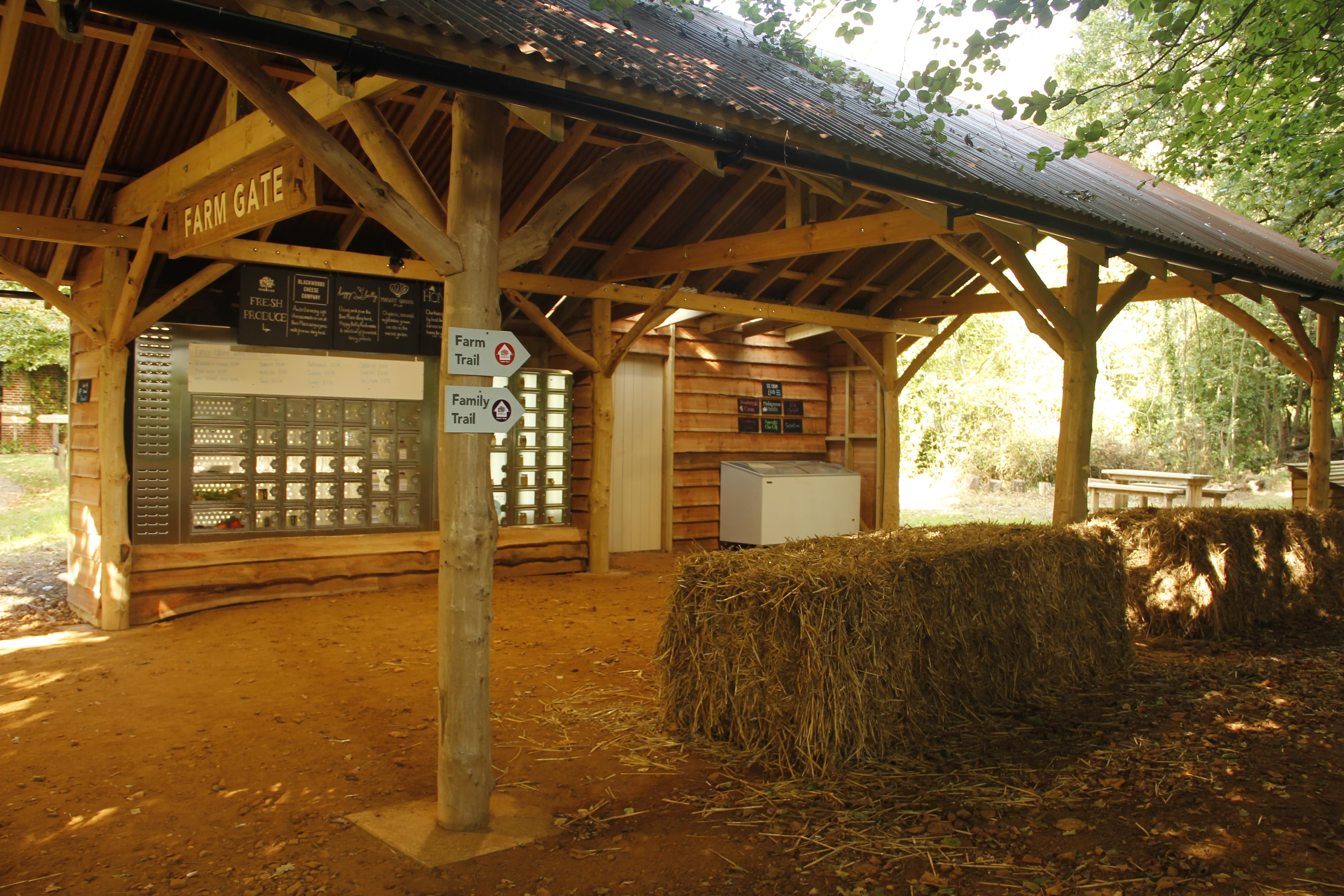
Jumping ahead to our farming practice in 2023, as outlined in our Strategic Plan under Priority 1 (Restorative and Regenerative Change), we acknowledge the environmental impact of our site’s footprint, and we are committed to farming regeneratively. The word regenerative is an important one as what it means is that we endeavour to put more back into nature than we take from it, a step further than sustainability which refers to a more circular model. Traditionally farming practises have gone against wildlife and the habitats they depend on, and we are in a time where our natural world is incredibly disconnected, including the human-nature side.
At Bore Place there are two strands of the word regenerative:
- We are working to enhance and reconnect habitats across our site to improve the abundance and dispersal of the species which rely upon these natural areas.
- Reconnecting people with nature through education, shared experiences, funded projects such as Green Recovery and Farming in Protected Landscapes
With this narrative in mind, as Project Co-ordinator of the project with a background in the creative sector I began planning how I could use these creative, visual attributes to my advantage to drive the importance of regenerative agriculture and connecting people to nature. We welcomed our on-site ecologist to the team in 2021 through Green Recovery funding provided by DEFRA, National Lottery Heritage Fund, Environment Agency and Natural England. They worked on our Habitat Management plan which outlines our 6 key indicator species/groups. At a similar time, I had our redundant milking parlour to refurbish into a visitor experience – and I got to thinking about how I could visually demonstrate our 6 key indicator species and bring them into the farming context to strengthen the relationship between both farming and ecology. So, I started sketching up ideas…

The next stage would be trying to turn the majority of the above into a reality! Although I paint in my free time and have taken on commissions, I had never even dreamt about attempting a mural before. This was the perfect opportunity to research this area and work out whether I could make it happen. From paint type to primer, I searched every corner and absorbed every bit of information out there to prepare me for painting at scale, but no matter how much I learned it was a matter of gathering all the confidence I had to put brush to wall. It turned out making the start was the biggest hurdle, everything flowed naturally after that.
I digitised my design, projected it onto the wall, scaled up the 6 key indicator species to make use of the wall space and started mixing my paints up. The first step was to paint the soil layer, earthworms, and beetles (although not a key indicator species, I felt the beetles were important as they are critical in monitoring soil health). I then started at the far-right hand side of the wall by creating the tree which symbolises the woodland habitat in which dormice – one of our indicator species live.
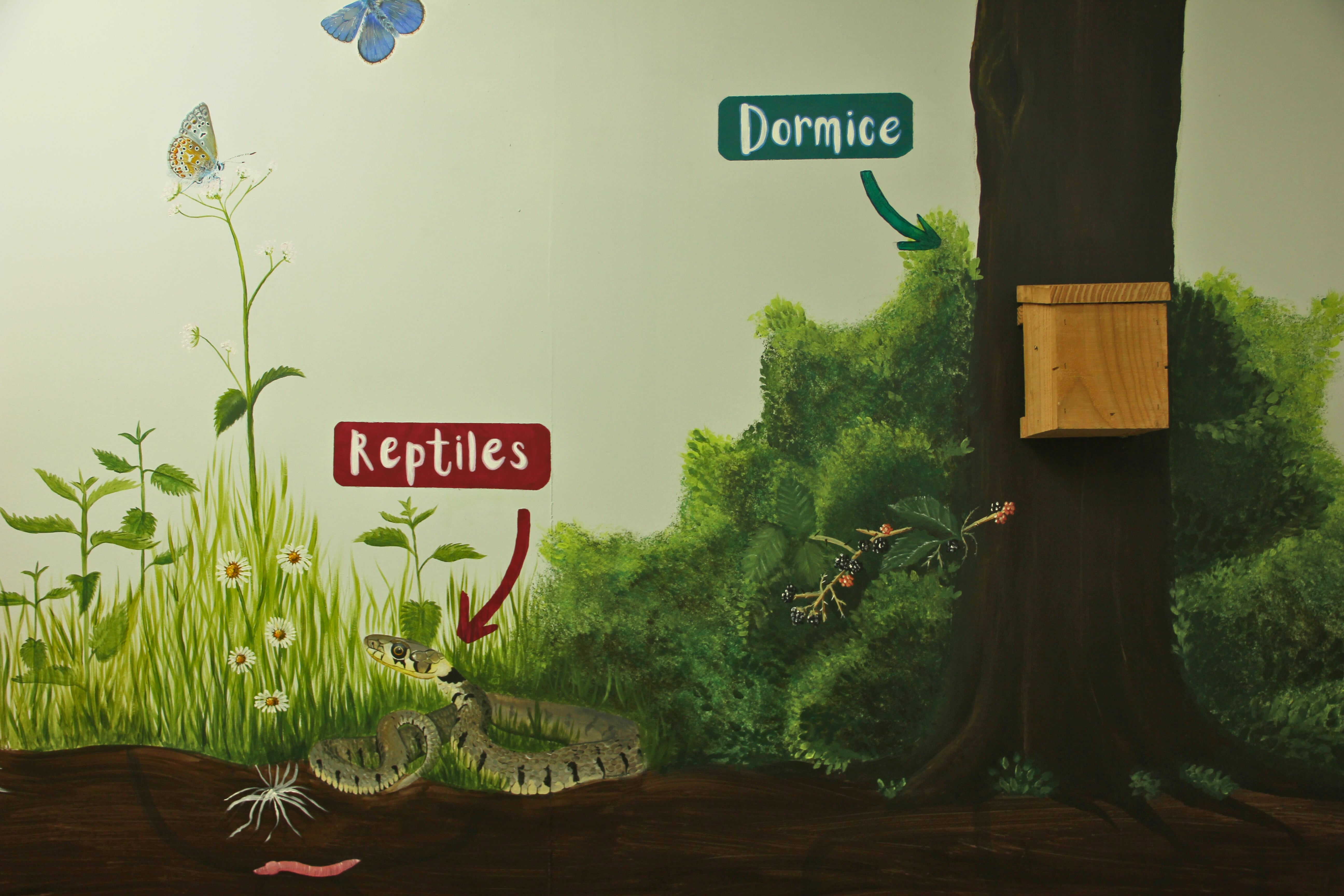
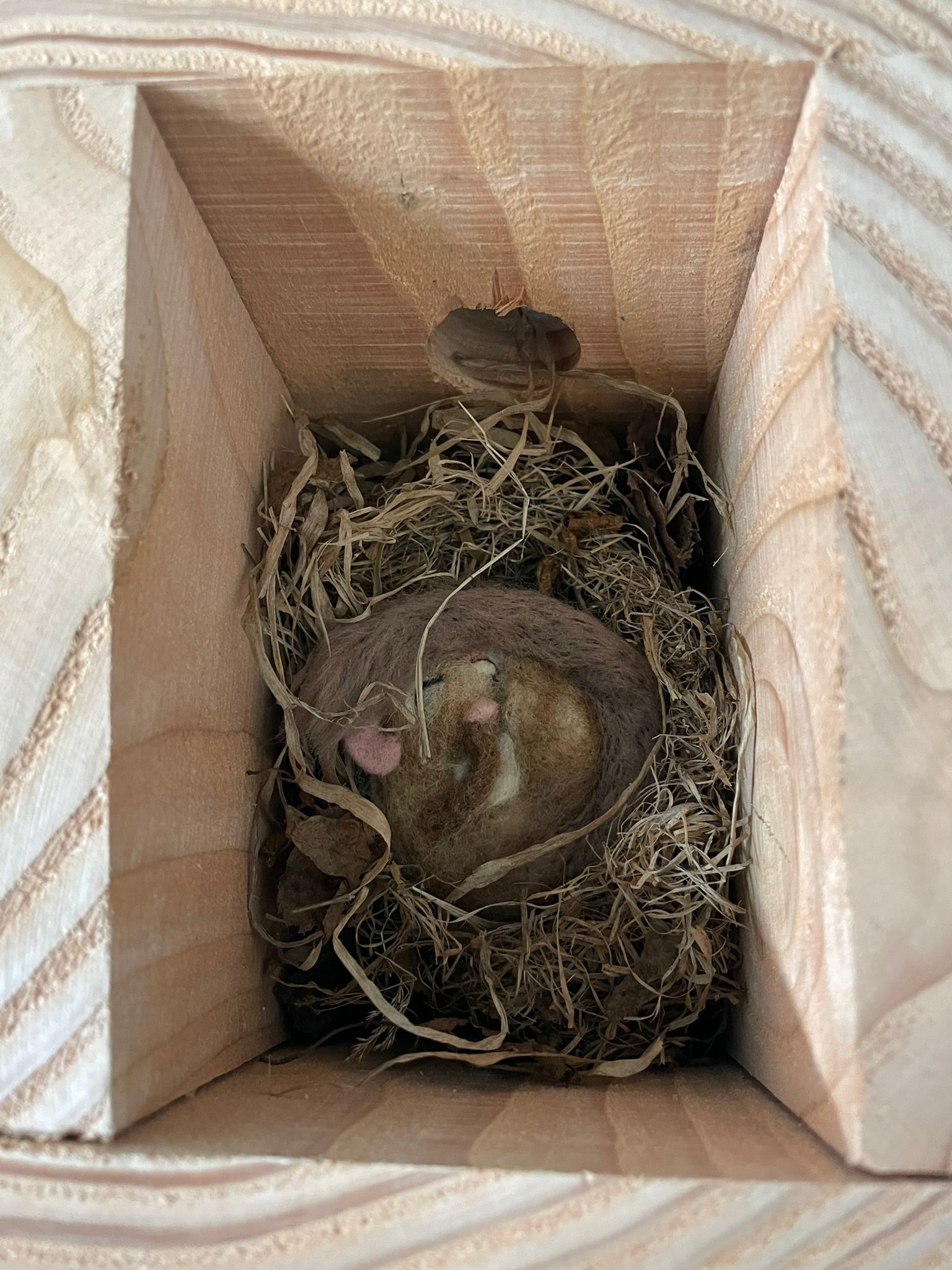
Dormouse box, plus close up of felted torpor dormouse
Dormice indicate beneficial woodland management which is the reason they have been selected as one of our key indicator species. Dormice require dense, woody, understory (medium size plants), and access to important food sources, such as hazel and bramble (hence the juicy blackberries conveniently located underneath the dormouse box on the mural!). By coppicing our woodland, we create variety within the habitat and allow the scrubby species preferred by dormice to grow. Coppicing operates on a cycle, by cutting some areas and leaving others. This creates a patchwork of habitats and pathways that allow the dormice to breed and disperse throughout the woodland.
I decided to mount a real dormouse box to the wall rather than paint this species because I wanted to recreate what the experience is like when surveying dormice, as it is extremely difficult to make this accessible to experience. Dormice are fully protected – meaning both the animals and their habitats are protected, therefore you must be licensed to survey this species. Whilst our licensed ecologist was carrying out some reparation to our dormouse boxes on site, she found a disused, beautifully woven nest built by our dormouse population at Bore Place. This is the nest you can see the felted torpor dormouse resting in on the mural.
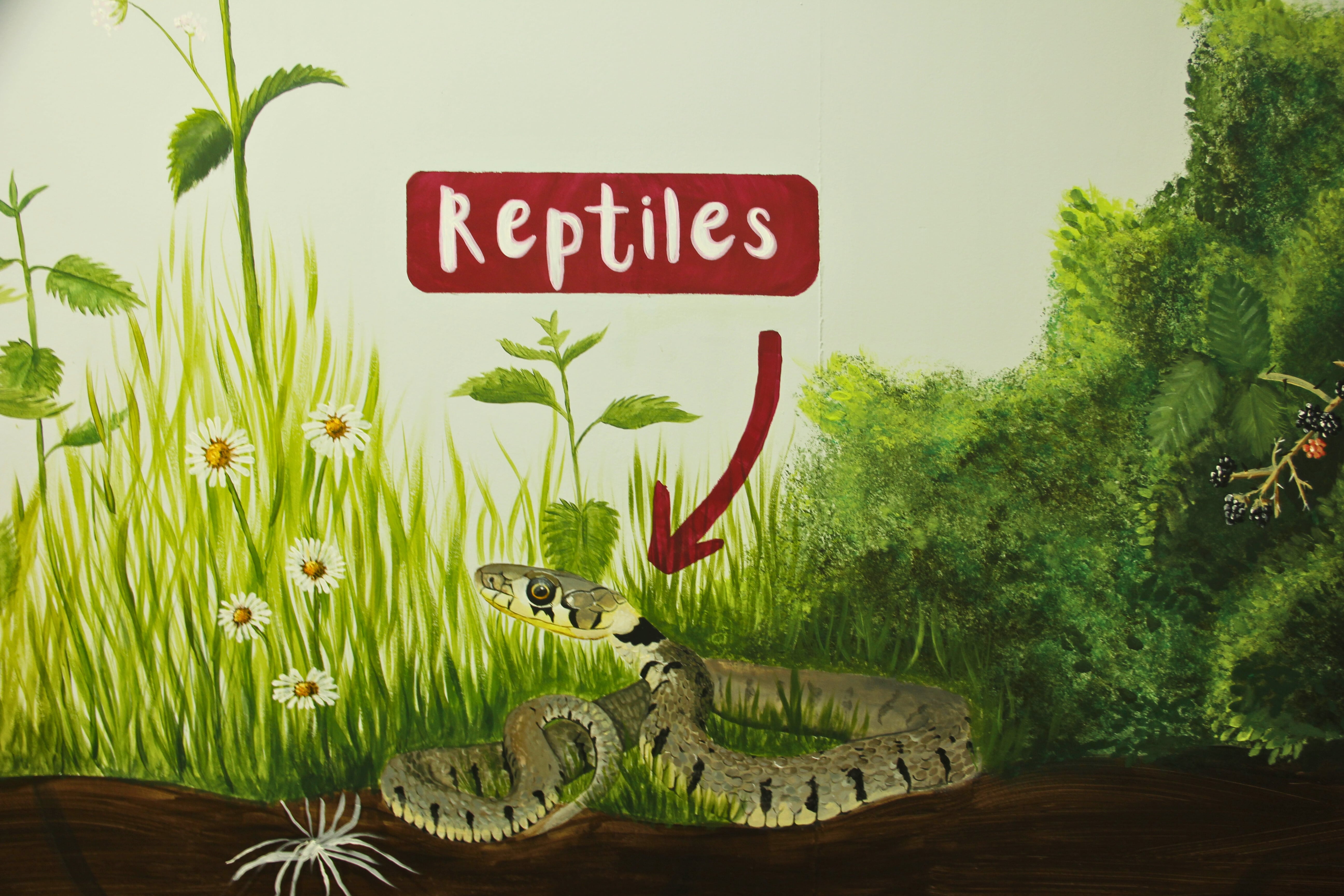
Close up of grass snake
Our second key indicator group is reptiles, which rely on scrubby edge habitat and good quality grassland margins. For this reason, they will allow us to monitor our ecological connections across the site. It’s essential that reptiles can populate new areas of habitat to sustain their population, therefore connections between suitable habitats are key to our management approach. Isolated populations are left vulnerable to dangers such as disease or flooding. We create wildlife corridors by planting new and improving existing hedgerows, field margins and wild areas to provide valuable connections to allow reptiles to travel between habitats to increase populations and distributions across our land. The rationale of choosing to paint the grass snake out of all our native reptile species is because they have an active presence at Bore Place, and we continue to successfully monitor them. Therefore, it is more likely for a member of the public visiting school group to see this in a real-life context at Bore Place.
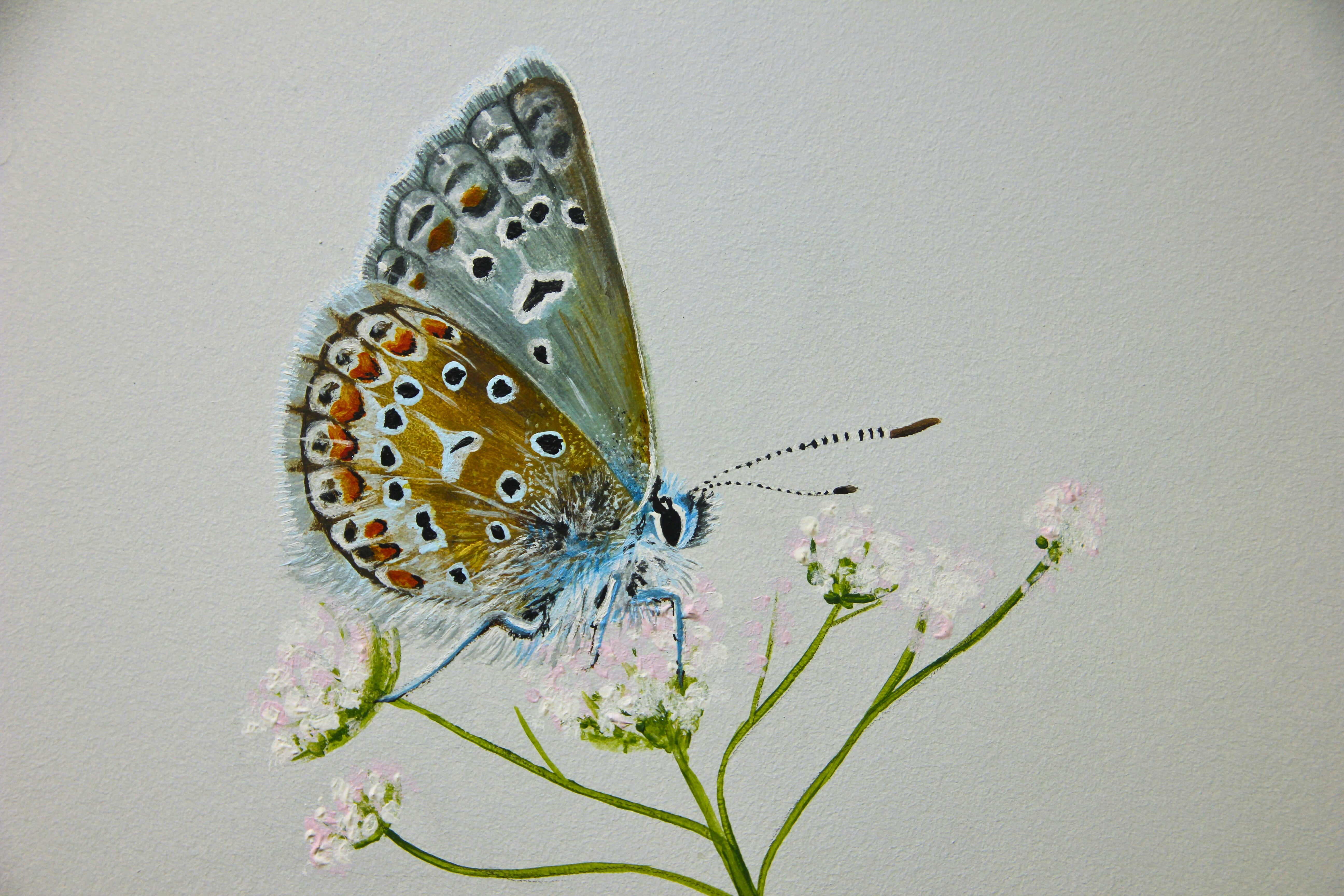
Close up of Common Blue Butterfly (under-wing)
As we travel back along the mural, the next species we notice is the Common Blue Butterfly. As suggested in the name, this butterfly is widespread across the UK and has not been selected due to population being low, but rather because they can help us get an indication of our botanical diversity. Increased diversity of botanical species such as birds-foot-trefoil (which is the main foodplant for the Common Blue Butterfly caterpillar) means that grassland habitat can support more butterfly and other invertebrate species. (insert birds-foot-trefoil image from painting). For educational purposes I painted both the under-wing and over-wing of the Common Blue Butterfly to demonstrate that both sides of the same butterfly can look incredibly different, and therefore it is important to be aware of this when identifying this type of species.
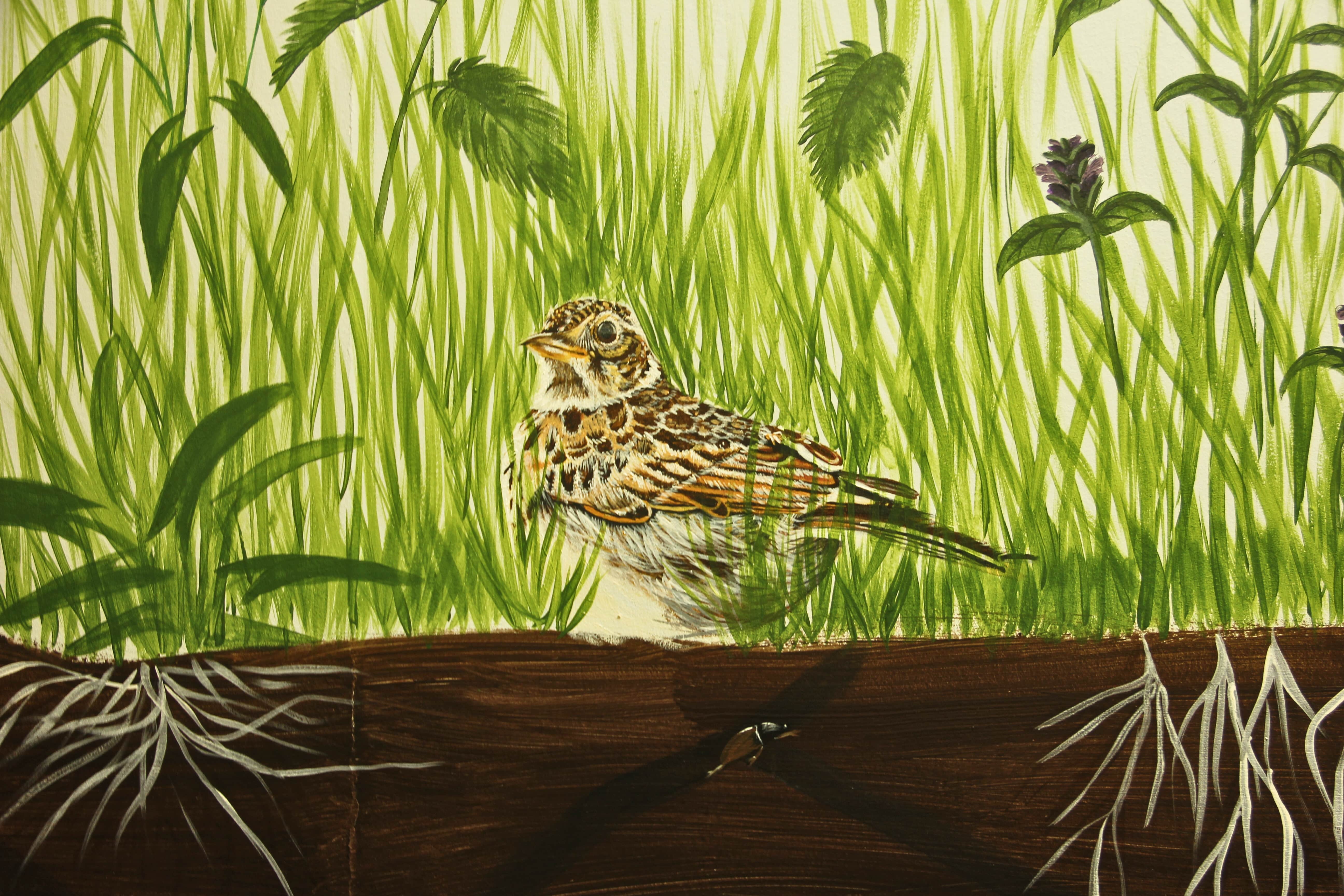
Close up of ground-nesting skylark
Skylark have been identified as another key indicator species. As we are an active dairy farm, a portion of our land is allocated as silage ground – this is grass which is harvested and fermented for our winter feed. Silaging ground creates good habitat for ground nesting birds such as Skylark and harvesting the grass could result in their nests being damaged or destroyed. Throughout the year, citizen scientists look out for nests and any that are found are flagged to the farm and an appropriate buffer area instigated to protect the nest until the young have successfully fledged. The ground-nesting part of this narrative is critical as to why I decided to paint both the ground-nesting mother bird, as well as the iconic skylark in flight – because if you have been lucky enough to experience this you will know that their trajectory into the sky is quite a noise and sight to behold!
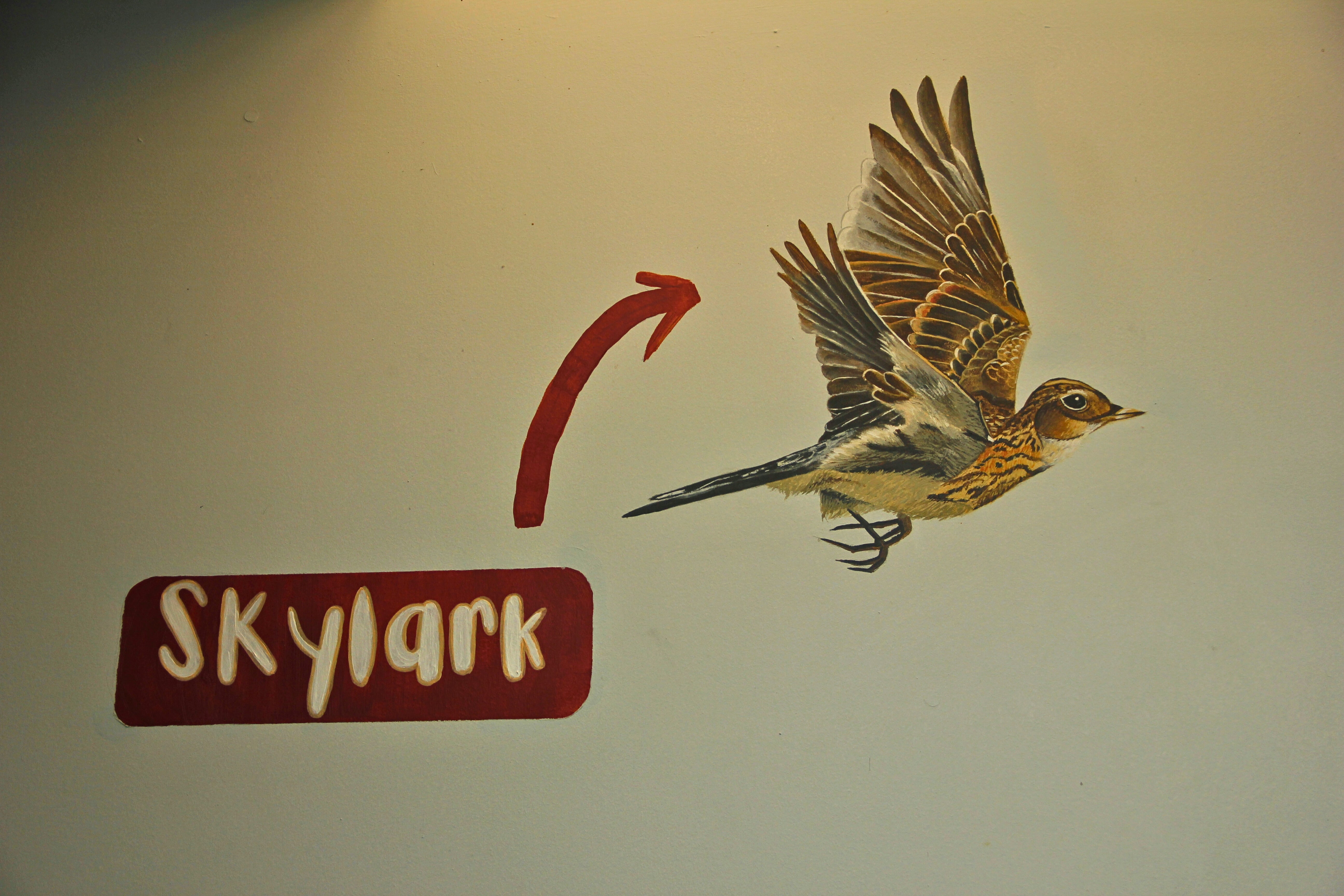
Close up of fledged skylark in flight
Dragonflies and damselflies are another of our key indicator species groups and have been identified to help us monitor water quality across the site. This species group lay their eggs in, or near, freshwater. Therefore, high numbers can indicate good water quality. Farming impacts water quality through the release of nutrients into aquatic environments. Slurry, manure, and animal waste all contribute to excess nutrient in waterways, which harm plant life and decrease the diversity of this habitat. The species painted on the mural is a male emperor dragonfly, other than it being a stunning example to use purely for aesthetic value, we monitor emperor dragonflies, and they have a strong presence here at Bore Place. Another of our key indicators that you can head out and try and spot for yourselves.
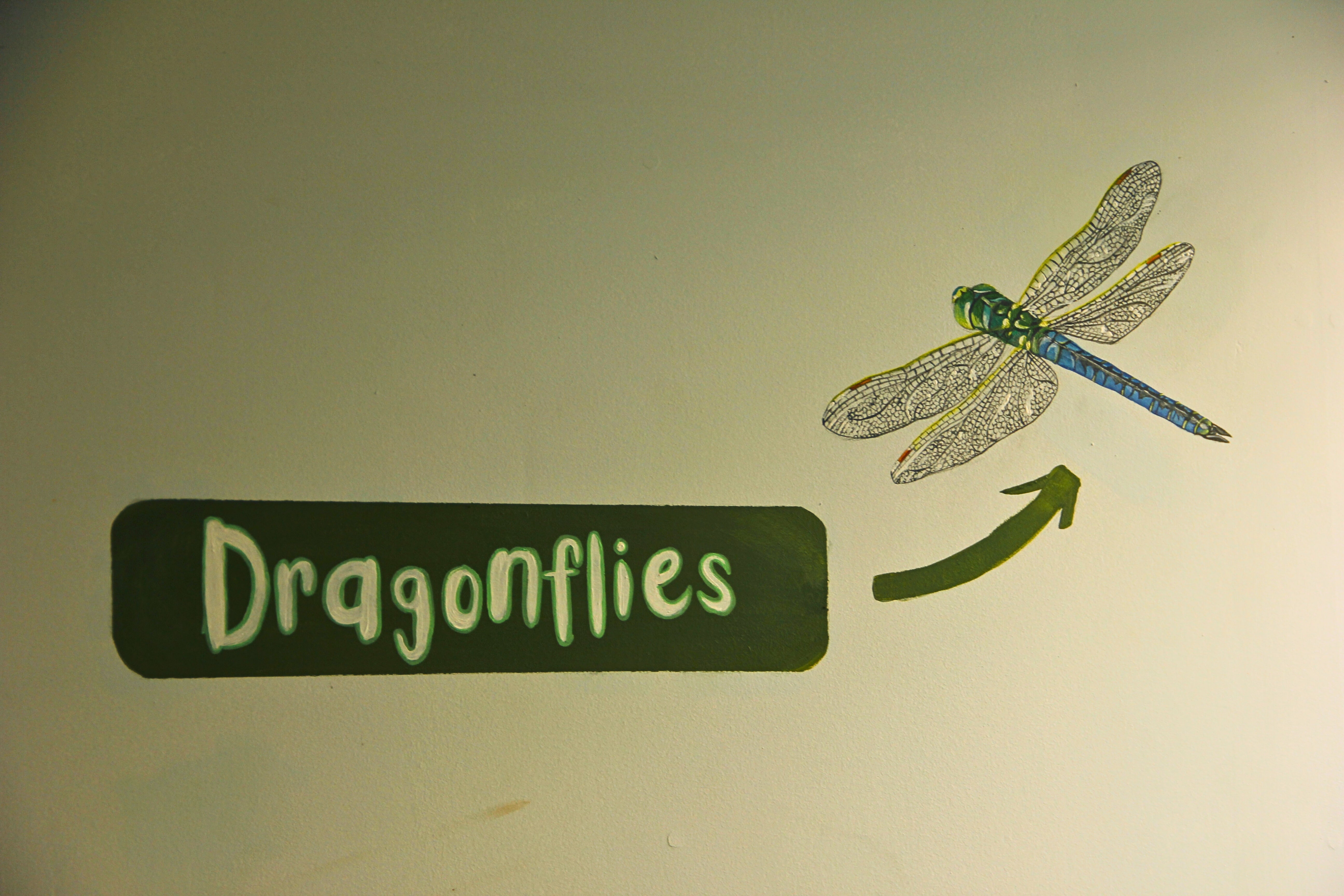
Close up of emperor dragonfly (male)
Our final indicator species is the humble earthworm! As intensive dairy farming across the country has led to soil degradation, it is imperative we begin to understand how to regenerate our soil as a nation. Our farm is certified organic by the Soil Association, which is worth mentioning as we do not apply any artificial pesticides, fungicides, or fertilisers. We only use natural soil enhancement methods such as farmyard manure, slurry and bokashi but as outlined above in the section on water quality these treatments still lead to high-nutrient run off which can be detrimental to biodiversity within our aquatic ecosystems. This additional information is worth stating because of the resilient nature soil has, it can recover itself, if the right inputs are balanced with minimal disturbance and livestock grazing is well managed.
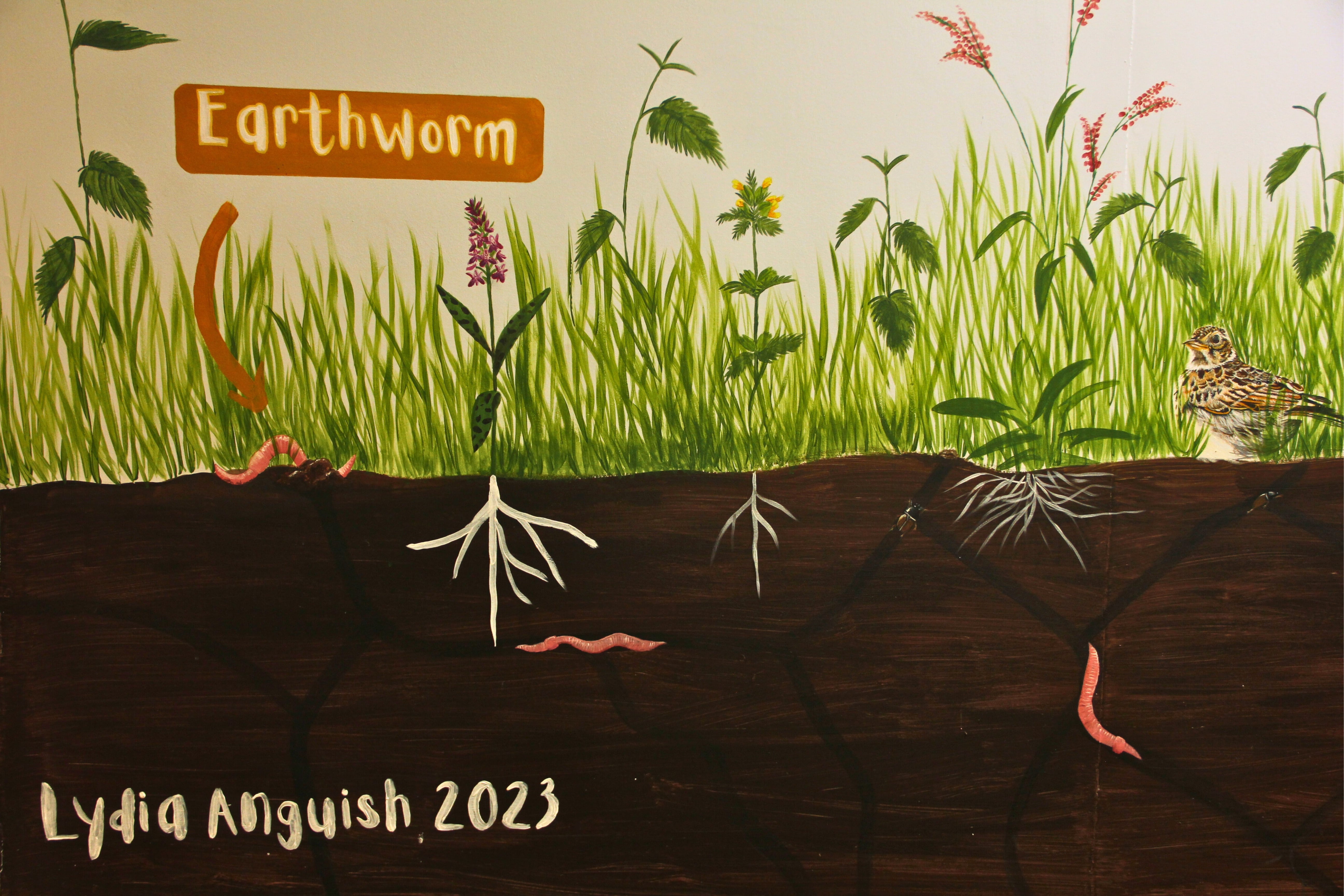
Close up of earthworm burrowing, plus soil layer inclusive of root depths
So, what role do earthworms play in all of this? Good question! Earthworms are sensitive to a variety of soil characteristics, including PH (acid/alkaline levels), water levels, compaction, and organic matter. Their presence also means that they are performing an important role in the ecosystem - incorporating nutrients into the soil, preventing soil erosion, improving aeration and drainage, and stimulating plant growth. So effectively earthworms are little soil soldiers, working tirelessly to improve their home by tidying up in the form of recycling nutrients, adding structure by creating channels to travel through and even provide a food source for other important species. At Bore Place we are working with our earthworms to return nutrients and organic matter to the soil and restore its fertility and productivity. Healthy soil has a higher water retention capacity which improves our resilience in a warming climate.
The plant species selected for the mural is the final element to delve into as we navigate a world where campaigns such as no mow may become more prominent in our annual calendars. Most native plant species that have been coined as ‘weeds’ (a weed is a wild plant growing where it is not wanted and in competition with cultivated plants) are vital to supporting many species of invertebrate, we need to reconnect ourselves with our native flora and address the level of human intervention and start challenging mindsets which are not open to these plant species having a place in our natural world. The diagram below shows the species that have been selected for this mural and the rationale behind each plant.
.jpg)
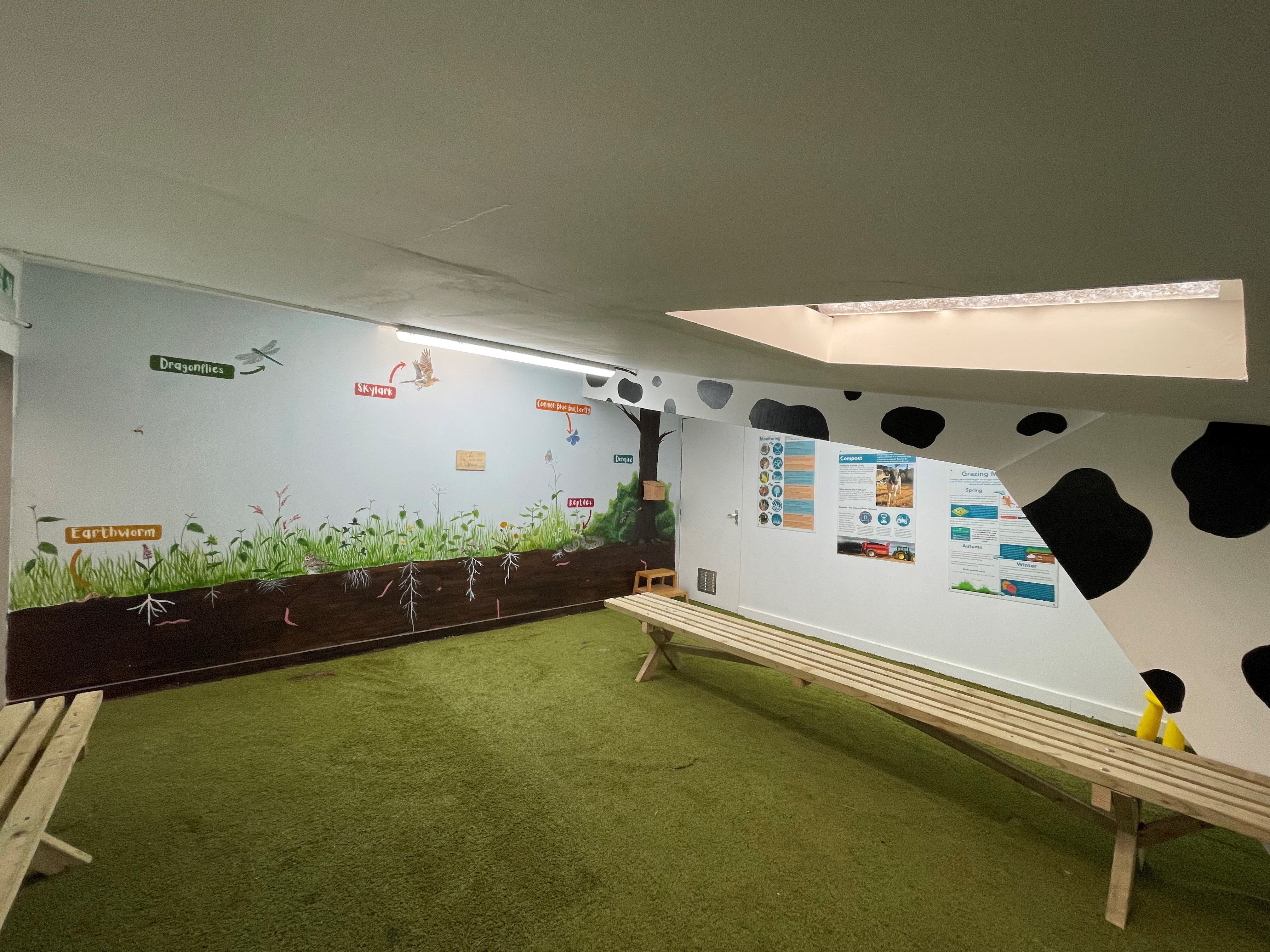
Finished mural wideshot located in observation lounge of The Milking Parlour